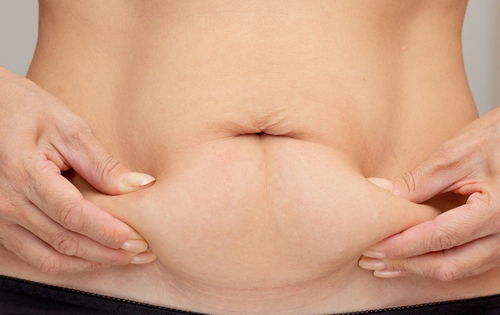How Chronic Stress Affects Fat Gain

Cortisol is the body’s primary stress hormone. It plays a key role in regulating numerous bodily functions, including metabolism. While essential for the "fight or flight" response that helped early humans survive dangerous situations, chronically elevated cortisol levels from modern-day stress can negatively impact weight management. This hormone stimulates both fat and carbohydrate metabolism to create a burst of energy.
Unfortunately, stress also increases appetite and triggers cravings for “comfort foods” like high-calorie, sugary, salty, and fatty foods. When stress becomes chronic, these cravings can make maintain a healthy diet much more challenging and often leads to unintended weight gain. While the body stores some of the excess energy as glycogen in the liver and muscles, these reserves are limited and excess energy is converted into triglycerides and stored in available fat cells.
Unlike the subcutaneous fat just under the skin, excess visceral fat is linked to significant health risks, including cardiovascular disease. Chronic stress can also cause the body to produce less testosterone, which may decrease muscle mass and slow down the rate at which you burn calories. These elevated cortisol can accelerate this process, which does favor deeper storage of visceral fat within the abdominal region surrounding organs.
What are the health risks of visceral fat deposits?
Adipose tissue, commonly known as body fat, is a type of connective tissue where the body stores energy in specialized cells called adipocytes. This tissue exists in two main forms: subcutaneous fat, which is located just beneath the skin, and visceral fat, which surrounds internal organs in the abdominal cavity. While both types of fat serve crucial roles, such as energy storage, hormone regulation, and organ cushioning, excess visceral fat poses significant health risks. But, unlike subcutaneous fat, visceral fat increases the likelihood of chronic health risks.
Visceral vs Subcutaneous Fat: The difference in danger of health risks between visceral fat and subcutaneous fat stems primarily from metabolic activity as well as the substances released. Excess visceral fat is more metabolically active and can release free fatty acids and other fat metabolites directly into the liver’s portal system. This can impair hepatic function, lead to fatty liver disease, and cause poor regulation of glucose and insulin metabolism.
Unfortunately, visceral fat is particularly influenced by cortisol and that affects how, when and where the body stores and mobilizes excess energy. Chronic stress leads to elevated cortisol levels, which prompt fat storage around the abdomen and create what is often referred to as a "cortisol belly." Moreover, this process can also disrupt metabolic processes and impair glucose regulation as well as contribute to insulin resistance and abnormal cholesterol levels that increase the likelihood of metabolic syndrome.
Cortisol’s Impact on Visceral Fat Storage
Cortisol is a vital steroid hormone produced mainly by the adrenal glands that plays a crucial role in the body’s stress natural stress response. More importantly, its primary function is to help regulate essential processes, including energy metabolism, immune system response, blood pressure, and blood glucose levels. During moments of stress, whether physical, emotional or mental, cortisol can spike as it is part of the body’s natural “fight” or “flight” response.
- Increased Food Cravings – Understanding faulty cortisol-driven eating patterns is crucial for breaking free from stress-induced overeating of less-healthy food choices. This is the first step in developing coping strategies.
- Cortisol Production in Tissues – Chronic stress releases more cortisol that can lead to abdominal obesity, as the steroid hormone signals the body to store excess energy in existing and newly created fat tissue.
- Excess Glucose Due to Insulin Resistance – What starts as your body's natural stress response can evolve into a serious health concern, where cells become completely unresponsive and resistant to insulin.
- Sleep and Hormonal Imbalances – Chronic stress can lead to poor quality of sleep, which in turn creates more stress. Moreover, this feedback loop intensifies cravings for unhealthy high-fat, high-calorie, and sugary foods.
- Visceral Fat Accumulation – Visceral fat doesn't just hang out passively around your organs. It actively responds to cortisol's fat-storing signals and creates cycles where stress leads to more abdominal fat accumulation.
Because visceral fat is more metabolically active, it releases inflammatory hormones that negatively influence metabolism. So, understanding how cortisol impacts metabolism and fat distribution highlights the importance of stress management for long-term results. Incorporating strategies like regular physical activity, a nutrient-rich diet, and effective stress-reduction techniques can help regulate cortisol levels, minimize its impact on the body, and promote overall well-being.
Do Women and Men Handle Cortisol Differently?
Cortisol hormone has a significant role in determining how the body stores fat, but its effects can differ notably between men and women. While the mechanisms of cortisol release and its effects on fat storage are somewhat universal, the way these mechanisms manifest can vary considerably between the sexes. The latest studies suggest it is likely the differences in biological factors and the body’s response to stress that influence how fat and where it accumulates.
Nonetheless, there are prominent distinction lies in how men and women cope with stress. Women are more likely to turn to high-calorie comfort foods as a coping mechanism, increasing their overall calorie intake and risk of weight gain. By contrast, men often resort to other harmful behaviors, such as smoking or drinking, to manage stress. These differing coping strategies interact uniquely with stress-driven cortisol elevations, further influencing fat storage patterns.
Men typically accumulate visceral fat, which surrounds internal organs and poses higher health risks like heart disease and diabetes. This fat distribution often creates an "apple-shaped" or central obesity pattern with belly fat. On the other hand, women tend to store fat subcutaneously, primarily in the hips, thighs, and buttocks. This "pear-shaped" fat distribution is thought to provide energy reserves for pregnancy and lactation, aligning with women’s evolutionary roles in childbearing.
______________________
If you are looking for a weight management plan personalized for your body, your lifestyle and your goals, MRC Lakewood is here to help. Metabolic Research Center has been helping people just like you to restore metabolic efficiency for decades. Take our 2-minute quiz to “Find Your Fit” and discover how our whole body wellness approach can put you on the right track. After all, we don’t believe in fad dieting and you’ll receive an instant download for our FREE Kickstart Guide that includes meal planning, recipes and much more.
By submitting this form, you agree to receive marketing text messages from us at the number provided, including messages sent by autodialer. Consent is not a condition of any purchase. Message and data rates may apply. Message frequency varies. Reply HELP for help or STOP to cancel. View our Privacy Policy and Terms of Service.

